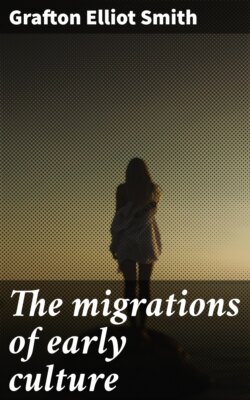Читать книгу The migrations of early culture - Grafton Elliot Smith - Страница 3
На сайте Литреса книга снята с продажи.
PREFACE.
ОглавлениеTable of Contents
When these pages were crudely flung together no fate was contemplated for them other than that of publication in the proceedings of a scientific society, as an appeal to ethnologists to recognise the error of their ways and repent. They were intended merely as a mass of evidence to force scientific men to recognise and admit that in former ages knowledge and culture spread in much the same way as they are known to be diffused to-day. The only difference is that the pace of migration has become accelerated.
The re-publication in book form was suggested by the Secretary of the Manchester University Press, who thought that the matters discussed in these pages would appeal to a much wider circle of readers than those who are given to reading scientific journals.
The argument is compounded largely of extracts from the writings of recognised authorities, and the author does not agree with all the statements in the various extracts he has quoted: this mode of presenting the case has been adopted deliberately, with the object of demonstrating that the generally admitted facts are capable of a more natural and convincing explanation than that put forth ex cathedra by the majority of modern anthropologists, one in fact more in accord with all that our own experience and the facts of history teach us of the effects of the contact of peoples and the spread of knowledge.
Such a method of stating the argument necessarily involves a considerable amount of repetition of statements and phrases, which is apt to irritate the reader and offend his sense of literary style. In extenuation of this admitted defect it must be remembered that the brochure was intended as a protest against the accusation of artificiality and improbability so often launched against the explanation suggested here: the cumulative effect of corroboration was deliberately aimed at, by showing that many investigators employing the most varied kinds of data had independently arrived at identical conclusions and often expressed them in similar phrases.
Only a very small fraction of the evidence is set forth in the present work. Much of the most illuminating information has only come to the author’s knowledge since this memoir was in the press; and a vast amount of the data, especially that relating to Europe, India and China, is too intimately intertwined with the effects of other cultures to be discussed and dissociated from them in so limited a space as this.
Nor has any attempt been made to discuss the times of the journeys, the duration of the intercourse, or the details of the goings and the comings of the ancient mariners who distributed so curious an assortment of varied cargoes to the coast-lines of the whole world—literally “from China to Peru.” They exerted an influence upon the history of civilization and achieved marvels of maritime daring that must be reckoned of greater account, as they were so many ages earlier, than those of the more notorious mediæval European adventurers and buccaneers who, impelled by similar motives, raided the Spanish Main and the East Indies.
As the pages show, this book is reprinted from volume 59, part 2, of the “Memoirs and Proceedings of the Manchester Literary and Philosophical Society,” session 1914-15; and I am indebted to the Council of that body for their kind permission to re-issue it in its present form.
G. Elliot Smith.
The University, Manchester, July, 1915.
